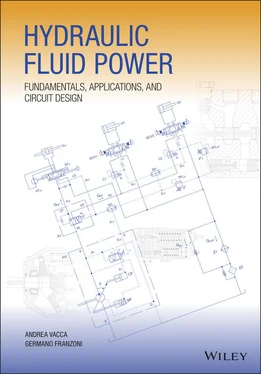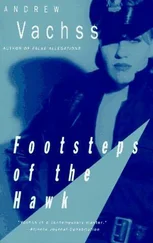1 ...6 7 8 10 11 12 ...38 Part I aims to familiarize the reader with the fundamental concepts and equations that will be used for the analysis of hydraulic circuits and hydraulic components. A reader already familiar with these concepts is still recommended to peruse the chapters of Part I, to be clear with the symbology and conventions used throughout the manuscript. After a thorough understanding of the contents presented in Part I, including the worked examples as well as the completion of the problems at the end of each chapter, the reader will be able to
1 Interpret circuits drawn with symbols of the ISO standard of representation.
2 Discuss the most common hydraulic fluids and describe the most important fluid properties affecting the operation of a hydraulic system.
3 Describe the concept of fluid cavitation or aeration and determine the effect on the fluid properties.
4 Describe the detrimental effects of solid contaminants in a hydraulic system.
5 Identify sources of energy loss, as turbulent or laminar hydraulic resistance.
6 Analyze flow forces in hydraulic components resulting from variation of fluid momentum.
7 Analyze the steady‐state operation of a flow network, based on the pressure law and flow law.
8 Derive the orifice equation starting from the fundamental Bernoulli equation.
9 Recognize the function of a specific orifice in a hydraulic network.
10 Discuss the concept of hydraulic resistance, hydraulic capacitance, and hydraulic inductance and their effects on the transient response of basic hydraulic systems.
11 Apply the concept of hydraulic resistance, hydraulic capacitance, and hydraulic inductance for basic analyses of hydraulic transients.
Chapter 1 Introduction to Hydraulic Control Technology
Hydraulic control systems are used across many engineering applications to provide motion and force control of mechanical systems. With respect to competing technologies for transmitting mechanical power (i.e. mechanical drives or electrical drives), hydraulic drives offer favorable characteristics from both the power to weight ratio and control perspectives. State‐of‐art hydraulic systems can be up to 1 order of magnitude lighter than electric systems with the same power (or torque) level. Also, compared with mechanical drives, hydraulic systems offer a greater layout flexibility thanks to the versatile design of the piping or hose system that connects the hydraulic components. Hydraulic drive technology also easily offers solutions for advanced actuator control, in terms of output velocity and force, motion reversals, and safety functions. These mentioned features are particularly advantageous in applications involving the transmission of large amounts of power. For this reason, hydraulics is a consolidated technology in many heavy‐duty applications, in manufacturing industry (hydraulic presses, molding machines, machining robots, etc.), and in mobile applications (construction, agriculture, aerospace, military, and marine). Recent progress in component miniaturization and interfacing with electronic controls have also brought hydraulic systems into emerging fields such as biomedical engineering (surgery robots, patient transfer and rehabilitation devices, etc.).
However, compared with other technologies for power transmission and motion control, hydraulics has some significant drawbacks, the most important one being the inevitable presence of energy losses. Depending on the application, other disadvantages might affect hydraulic systems, such as the high influence of temperature on the system behavior, the possible insurgence of leakages, and the limited duration of the working fluid, due to aging or contamination.
From the considerations made above, it appears clear how a “best technology” for transmitting mechanical power does not exist in absolute. The most suitable technology for a given application is usually the result of a compromise between initial and operating costs, functionality, durability, reliability, and safety. Consequently, it is very important for a designer to be fully aware of the possible technological alternatives that can be available for the system under evaluation from the early design stages. Too often a designer chooses the technology for which she/he has more experience, without considering alternatives. Due to the chronic lack in fluid power education in engineering schools, hydraulic control technology is seldom the preferred designer's choice. This book aims to fill this gap by educating current and future generations of designers on the potentials of hydraulic control technology.
1.1 Historical Perspective
The science of “hydraulic fluid power” (mostly known as “hydraulics”) dates back from the ancient cultures. Earliest uses of hydraulic structures, such as dams, levees, and water distribution networks, were made by Egyptians, Romans, and Chinese populations even more than 2000 years ago. The term “hydraulics” originates from the Greek word hydraulikos compiled from hudôr (water) and autos (pipe).
Fluid power is a discipline studying systems and machines that use fluids to perform mechanical actuations. Fluid power is subdivided into hydraulicsand pneumatics. Hydraulic systems use liquids as fluid media. Instead, pneumatic systems use compressed air.
Basic principles for transferring fluids were already put in practice by Archimedes in the third century BCE. The first fundamental hydraulic laws were outlined in his work “Treatise on Floating Bodies.” The principles discovered by Archimedes are the same that are governing the operation of modern‐day hydrostatic units. However, his inventions did not reach the force multiplication potentials offered by fluid, as discovered by Blaise Pascal in the seventeenth century. In fact, it is the seventeenth century that marks the appearance of the first pumps or closed‐circuit applications. The following discoveries have relevance in the history of fluid power:
The first axial piston pump design was conceived by A. Ramelli ( Figure 1.1) in the year 1588. The basic elements of a modern axial piston pump have not changed significantly from the first design idea by Ramelli.
The first gear pump effectively used by Pappenheim in 1636.
The first machine that ushered in the modern era of hydraulics is the hydraulic press attributed to Joseph Bramah (1795). Many hydraulics machines assisted the industrial revolution in Europe, providing methods for power transmissions alternative to belts and mechanical drivetrains. Some European cities in the 1860s were equipped with central fluid power generating stations.
The major technological breakthrough in modern hydraulic technology was the introduction of oil as the working fluid in the early 1900s. The Waterbury Tool Company in 1905 introduced for the first time a variable flow rate pump operating with oil. The pump was capable of delivering about 120 l/min at 50 bar for a maximum shaft speed of 300 rpm, and it weighed about 300 kg. The use of oil in place of water, as in prior systems, permitted the hydrostatic units to operate reliably at higher pressure, thus reaching superior power to weight ratios. The first full hydraulic transmission system working with oil is considered to be the hydrostatic transmission system presented by Williams and Janney in 1905 to propel one of the first infantry tanks ( Figure 1.2). Oil was also used for the first modern hydraulic system used in marine application in 1906. This was when a hydraulic system was developed to replace the electrical system that controlled the guns in the USS Virginia. This was the beginning of the modern era for fluid power.
After some decades of stagnation, during the great economic depression of the 1930s, renewed interest for fluid power technology emerged during the Second World War. This was driven by the need for high‐power transmissions for ground and marine equipment, the requirement for precise and rapid aiming systems for heavy guns, and the need of precise control for aircraft fighters. It is during these years when fluid power technology moved from being a craft to becoming a serial production industry. The decades following the Second World War are known as the golden era of fluid power; many entrepreneurs and inventors pioneered the creation of new components and technologies around the world. In this period before the advent of computers, control challenges were solved in many elegant ways, thanks to the creativity of some brilliant minds. For example, in the United States, Harry Vickers (1898–1977) is considered the greatest fluid power pioneer. He founded Vickers Corp. and performed many inventions such as the pressure balanced vane pump and the hydraulic power steering. Later in the years, Vickers Corp. acquired the electronic divisions of Sperry Corp. in 1978, which sparked several advancements made in the field of solenoid valves and proportional controls for industrial valves. Aeroquip‐Vickers was acquired by Eaton Corp. in 1999.
Читать дальше












